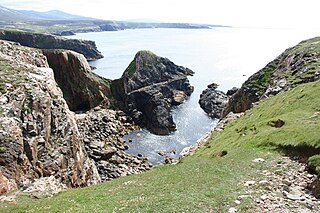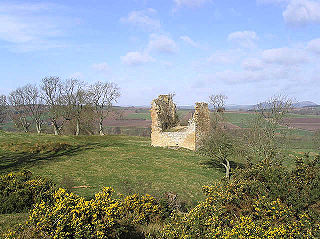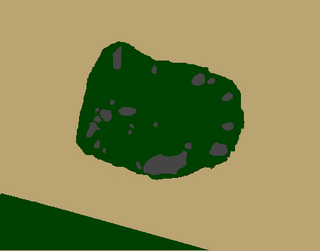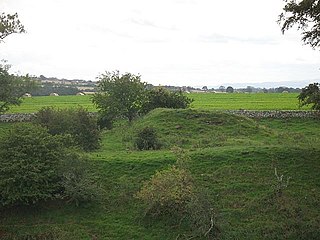
The Washington Monument is an obelisk within the National Mall in Washington, D.C., built to commemorate George Washington, once commander-in-chief of the Continental Army (1775–1784) in the American Revolutionary War and the first President of the United States (1789–1797). Located almost due east of the Reflecting Pool and the Lincoln Memorial, the monument, made of marble, granite, and bluestone gneiss, is both the world's tallest predominantly stone structure and the world's tallest obelisk, standing 554 feet 7 11⁄32 inches (169.046 m) tall according to the U.S. National Geodetic Survey or 555 feet 5 1⁄8 inches (169.294 m) tall according to the National Park Service. It is the tallest monumental column in the world if all are measured above their pedestrian entrances. Overtaking the Cologne Cathedral, it was the tallest structure in the world between 1884 and 1889, after which it was overtaken by the Eiffel Tower in Paris.

The Scott Monument is a Victorian Gothic monument to Scottish author Sir Walter Scott. It is the second largest monument to a writer in the world after the José Martí monument in Havana. It stands in Princes Street Gardens in Edinburgh, opposite the Jenners department store on Princes Street and near to Edinburgh Waverley Railway Station, which is named after Scott's Waverley novels.

The Standing Stones of Stenness is a Neolithic monument five miles northeast of Stromness on the mainland of Orkney, Scotland. This may be the oldest henge site in the British Isles. Various traditions associated with the stones survived into the modern era and they form part of the Heart of Neolithic Orkney World Heritage Site. They are looked after by Historic Environment Scotland as a scheduled monument.

The Clach a' Charridh or Shandwick Stone is a Class II Pictish stone located near Shandwick on the Tarbat peninsula in Easter Ross, Scotland. It is a scheduled monument.

Ballymeanoch is a complex of neolithic structures located in Kilmartin Glen, Scotland.

Temple Wood is an ancient site located in Kilmartin Glen, near Kintyre, Argyll, Scotland. The site includes two circles. The southern circle contains a ring of 13 standing stones about 12 metres in diameter. In the past it may have had 22 stones. In the centre is a burial cist surrounded by a circle of stones about 3 metres in diameter. Other later burials are associated with the circle. According to the Historic Scotland information marker at the site, the southern circle's first incarnation may have been constructed around 3000 BC.

Fatlips Castle is a peel tower in Roxburghshire, in the Scottish Borders. Situated at the top of Minto Crags, above the River Teviot, it was built in the 16th century by the Turnbulls of Barnhills, notorious Border reivers, and owners of nearby Barnhills Tower and farm. In 1545, during the War of the Rough Wooing, the Earl of Hertford burned "Mantoncrake", or Mynto Crag.

The Burns Monument in Kay Park, Kilmarnock, Scotland, commemorates the poet Robert Burns (1759–1796). It is located at an elevated position within Kay Park, to the east of Kilmarnock Town Centre. The monument was opened in 1879, and is a category B listed building. In 2004 a fire destroyed part of the monument. The building was restored and extended as a genealogy centre, reopening as the Burns Monument Centre in 2009.

Brechin Cathedral dates from the 13th century. As a congregation of the Church of Scotland, which is Presbyterian, the church is not technically a cathedral, in spite of its name.

Stac Dhòmnuill Chaim, or Stac Dhòmhnaill Chaim, is a fortified promontory located near Mangursta on the Isle of Lewis in the Outer Hebrides of Scotland. The stack and its surrounding site is listed and protected as a scheduled monument, one of about 8,000 sites currently protected in Scotland. The site of the stack is located at grid reference NB00223152. The site is named after Donald Cam Macaulay, the early 17th century hero of the Macaulays of Uig. The site was documented in the late 19th century, but today it is considered inaccessible. In 2003 and 2006, an archaeological team of rock climbers scaled the promontory and documented the site; finding in 2006 a piece of possibly Neolithic pottery.
Bertha is the name of the site of a Roman fort north of the site of modern Perth, Scotland, at the confluence of the rivers Almond and Tay. It is half a mile east of the modern farm of "Berthapark" and is a scheduled ancient monument.

Timpendean Tower (tim-pen-deen) or Typenden Castle as it was once known, is a ruined 15th-century tower house near Lanton, around 1.5 miles (2.4 km) north-west of Jedburgh in the Scottish Borders.

Drochil Castle is a ruined castle in the Scottish Borders. It is located above the Lyne Water, 10 kilometres (6.2 mi) north-west of Peebles, and 8 kilometres (5.0 mi) south of West Linton.
Kirkwall Castle, also known as King's Castle, was located in Kirkwall, the main settlement in the Orkney Islands of Scotland. Built in the 14th century, it was deliberately destroyed in 1614. The last ruins were cleared in the 19th century. The castle was located around the corner of Broad Street and Castle Street in the centre of Kirkwall.

Yonder Bognie is a stone circle in Aberdeenshire, Scotland. It is located in an agricultural field under private ownership and is a scheduled monument.

The Nelson Monument is a commemorative obelisk built in 1806 in honour of Vice Admiral Horatio Nelson, constructed the year after his death at the Battle of Trafalgar. It is located within Glasgow Green, a historic public park in Glasgow, Scotland. It stands 144 feet (44 m) tall, and its square plinth is enclosed by cast iron railings.
Harden Castle is a 16th century tower house, about 3.5 miles (5.6 km) west of Hawick, Scottish Borders. It is alternatively known as Harden House or Harden Tower.

Midmar is a historic settlement in Aberdeenshire, lying north of Banchory and southwest of Inverurie. It is noted for its three stone circles and various standing stones. Midmar and Sunhoney are both recumbent stone circles.

Billie Castle is a ruined 15th century quadrangular castle, 3 miles (4.8 km) north west of Chirnside, Scottish Borders, Scotland, north of Billiemains. It was designated as a scheduled monument in 1988.

Loanhead of Daviot stone circle is a recumbent stone circle in Aberdeenshire in lowland northeast Scotland. The circle consists of the recumbent stone with its flankers and a complete set of eight orthostats about 21 metres (69 ft) in diameter surrounding a low kerbed ring cairn which has an open court. However, the present appearance has in part been produced by substantial restoration after archaeological excavation in 1934, and in 1989 by the removal of the stones covering the central court.

















